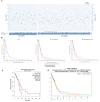NT5E/CD73 as Correlative Factor of Patient Survival and Natural Killer Cell Infiltration in Glioblastoma
- PMID: 31547570
- PMCID: PMC6832588
- DOI: 10.3390/jcm8101526
NT5E/CD73 as Correlative Factor of Patient Survival and Natural Killer Cell Infiltration in Glioblastoma
Abstract
CD73, a cell-surface protein encoded by the gene NT5E, is overexpressed in glioblastoma (GBM), where it contributes to the tumor's pathophysiology via the generation of immunosuppressive adenosine. Adenosinergic signaling, in turn, drives immunosuppression of natural killer (NK) cells through metabolic and functional reprogramming. The correlation of CD73 with patient survival in relation to GBM pathology and the intratumoral infiltration of NK cells has not been comprehensively studied before. Here, we present an analysis of the prognostic relevance of CD73 in GBM based on transcriptional gene expression from patient data from The Cancer Genome Atlas (TCGA) database. Utilizing bioinformatics data mining tools, we explore the relationship between GBM prognosis, NT5E expression, and intratumoral presence of NK cells. Our analysis demonstrates that CD73 is a negative prognostic factor for GBM and that presence of NK cells may associate with improved prognosis. Moreover, the interplay between expression of NT5E and specific NK genes hints to potential functional effects of CD73 on NK cell activation.
Keywords: CD73; adenosine; glioblastoma; immunometabolism; natural killer cells.
Conflict of interest statement
The authors declare no conflict of interest.
Figures





Similar articles
-
Multispecific targeting of glioblastoma with tumor microenvironment-responsive multifunctional engineered NK cells.Proc Natl Acad Sci U S A. 2021 Nov 9;118(45):e2107507118. doi: 10.1073/pnas.2107507118. Proc Natl Acad Sci U S A. 2021. PMID: 34740973 Free PMC article.
-
Engineered natural killer cells impede the immunometabolic CD73-adenosine axis in solid tumors.Elife. 2022 Jul 11;11:e73699. doi: 10.7554/eLife.73699. Elife. 2022. PMID: 35815945 Free PMC article.
-
Immunometabolic Dysfunction of Natural Killer Cells Mediated by the Hypoxia-CD73 Axis in Solid Tumors.Front Mol Biosci. 2019 Jul 24;6:60. doi: 10.3389/fmolb.2019.00060. eCollection 2019. Front Mol Biosci. 2019. PMID: 31396523 Free PMC article. Review.
-
Functional expression of CD73 on human natural killer cells.Cancer Immunol Immunother. 2022 Dec;71(12):3043-3056. doi: 10.1007/s00262-022-03219-z. Epub 2022 May 25. Cancer Immunol Immunother. 2022. PMID: 35622118 Free PMC article.
-
Adenosinergic signaling as a target for natural killer cell immunotherapy.J Mol Med (Berl). 2018 Sep;96(9):903-913. doi: 10.1007/s00109-018-1679-9. Epub 2018 Aug 1. J Mol Med (Berl). 2018. PMID: 30069747 Review.
Cited by
-
Advances in NK cell therapy for brain tumors.NPJ Precis Oncol. 2023 Feb 15;7(1):17. doi: 10.1038/s41698-023-00356-1. NPJ Precis Oncol. 2023. PMID: 36792722 Free PMC article. Review.
-
Multispecific targeting of glioblastoma with tumor microenvironment-responsive multifunctional engineered NK cells.Proc Natl Acad Sci U S A. 2021 Nov 9;118(45):e2107507118. doi: 10.1073/pnas.2107507118. Proc Natl Acad Sci U S A. 2021. PMID: 34740973 Free PMC article.
-
Harnessing NK cells for cancer immunotherapy: immune checkpoint receptors and chimeric antigen receptors.BMB Rep. 2021 Jan;54(1):44-58. doi: 10.5483/BMBRep.2021.54.1.214. BMB Rep. 2021. PMID: 33298244 Free PMC article. Review.
-
mRNA markers for survival prediction in glioblastoma multiforme patients: a systematic review with bioinformatic analyses.BMC Cancer. 2024 May 21;24(1):612. doi: 10.1186/s12885-024-12345-z. BMC Cancer. 2024. PMID: 38773447 Free PMC article.
-
ENTPD1 (CD39) and NT5E (CD73) expression in human glioblastoma: an in silico analysis.Purinergic Signal. 2024 Jun;20(3):285-289. doi: 10.1007/s11302-023-09951-0. Epub 2023 Jul 4. Purinergic Signal. 2024. PMID: 37402102 Free PMC article.
References
Grants and funding
LinkOut - more resources
Full Text Sources
Other Literature Sources
Research Materials
Miscellaneous

